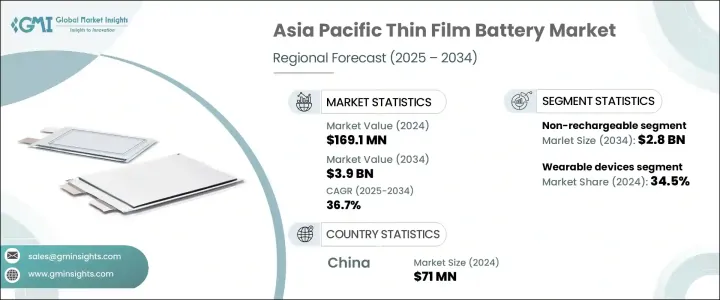PUBLISHER: Global Market Insights Inc. | PRODUCT CODE: 1721518

PUBLISHER: Global Market Insights Inc. | PRODUCT CODE: 1721518
Asia Pacific Thin Film Battery Market Opportunity, Growth Drivers, Industry Trend Analysis, and Forecast 2025 - 2034
Asia Pacific Thin Film Battery Market was valued at USD 169.1 million in 2024 and is estimated to grow at a CAGR of 36.7% to reach USD 3.9 billion by 2034. The region is a major player in renewable energy, especially in solar and wind power, and is experiencing a rising demand for energy storage solutions to balance power generation and consumption. Thin film batteries, known for their miniaturized form and high efficiency, are becoming increasingly popular for small-scale energy storage systems in homes and businesses. As the need for sustainable energy solutions grows, these batteries are gaining traction due to their compactness and performance in various applications.

Given the region's leadership in the renewable energy sector, there is a growing demand for energy storage systems that can store energy produced by renewable sources and help smooth fluctuations in power supply. Thin film batteries, due to their scalability and compact design, offer a practical solution for small-scale energy storage. As more homes and businesses adopt renewable energy systems, the role of these batteries in ensuring consistent power supply becomes more critical. Additionally, the compact nature of thin film batteries makes them ideal for portable applications, contributing to their growing popularity in wearable devices, medical tools, and other small-scale energy needs.
| Market Scope | |
|---|---|
| Start Year | 2024 |
| Forecast Year | 2025-2034 |
| Start Value | $169.1 Million |
| Forecast Value | $3.9 Billion |
| CAGR | 36.7% |
The non-rechargeable thin film battery segment is expected to dominate the market, potentially generating USD 2.8 billion by 2034. These batteries are highly suitable for applications requiring a one-time power source, such as RFID tags, medical devices, and sensors. Non-rechargeable thin film batteries provide a lightweight, efficient energy solution for space-constrained or disposable products where recharging is not an option. Their small size and flexibility make them ideal for such uses, driving demand in industries where minimal, short-term power is needed.
The wearable devices sector is predicted to hold a significant market share, with an estimated 34.5% share in 2024. These devices require flexible, lightweight batteries with high energy density, characteristics that thin film batteries provide. As the demand for health and fitness wearables like heart rate monitors and fitness trackers grows, the need for reliable and long-lasting power sources becomes essential. Thin film batteries are well-suited for powering these devices, offering high performance without adding bulk or weight.
China Thin Film Battery Industry generated USD 71 million in 2024. The country's dominance in battery manufacturing and large-scale production facilities has reduced production costs and helped improve the supply chain for thin film batteries. With large-scale production capabilities, China can meet the growing demand for these batteries, not only within its borders but also globally. The government's support for clean energy technologies, including energy storage solutions, further strengthens China's position as a key player in the market. As the demand for renewable energy sources continues to rise, China's strategic investments in the thin film battery sector are expected to maintain its competitive edge in the global marketplace.
Key players in the Asia Pacific Thin Film Battery Market include Molex, Prieto Battery, Imprint Energy, STMicroelectronics, Ion Storage Systems, and Enfucell Flexible Electronics. These companies are strengthening their market presence through technological innovations, cost-reduction strategies, and expanding production capabilities. Additionally, they are forming strategic partnerships to enhance their product offerings and improve market penetration. The focus on increasing energy storage efficiency and meeting the growing demand for sustainable energy solutions is central to their growth strategies. By investing in research & development, these players are advancing the performance and versatility of thin film batteries, making them more attractive for a wider range of applications.
Table of Contents
Chapter 1 Methodology & Scope
- 1.1 Market definitions
- 1.2 Base estimates & calculations
- 1.3 Forecast calculation
- 1.4 Data sources
- 1.4.1 Primary
- 1.4.2 Secondary
- 1.4.2.1 Paid
- 1.4.2.2 Public
Chapter 2 Industry Insights
- 2.1 Industry ecosystem analysis
- 2.2 Regulatory landscape
- 2.3 Industry impact forces
- 2.3.1 Growth drivers
- 2.3.2 Industry pitfalls & challenges
- 2.4 Growth potential analysis
- 2.5 Porter's analysis
- 2.5.1 Bargaining power of suppliers
- 2.5.2 Bargaining power of buyers
- 2.5.3 Threat of new entrants
- 2.5.4 Threat of substitutes
- 2.6 PESTEL analysis
Chapter 3 Competitive Landscape, 2024
- 3.1 Introduction
- 3.2 Strategic outlook
- 3.3 Innovation & sustainability landscape
Chapter 4 Market Size and Forecast, By Product, 2021 - 2034, (USD Million)
- 4.1 Key trends
- 4.2 Rechargeable
- 4.3 Non-rechargeable
Chapter 5 Market Size and Forecast, By Application, 2021 - 2034, (USD Million)
- 5.1 Key trends
- 5.2 Wearable devices
- 5.3 Medical
- 5.4 Smart cards
- 5.5 Consumer products
- 5.6 Others
Chapter 6 Market Size and Forecast, By Country, 2021 - 2034, (USD Million)
- 6.1 Key trends
- 6.2 China
- 6.3 Japan
- 6.4 South Korea
- 6.5 India
- 6.6 Australia
Chapter 7 Company Profiles
- 7.1 BrightVolt Solid State Batteries
- 7.2 Cymbet
- 7.3 Enfucell Flexible Electronics
- 7.4 Ilika
- 7.5 Imprint Energy
- 7.6 Ion Storage Systems
- 7.7 ITEN
- 7.8 Jenax
- 7.9 Johnson Energy Storage
- 7.10 Molex
- 7.11 Prieto Battery
- 7.12 STMicroelectronics




